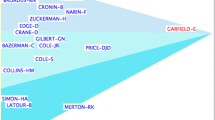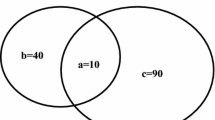Abstract
A central idea in Dan Sperber and Deirdre Wilson’s relevance theory is that an individual’s sense of the relevance of an input varies directly with the cognitive effects, and inversely with the processing effort, of the input in a context. I argue that this idea has an objective analog in information science—the tf*idf (term frequency, inverse document frequency) formula used to weight indexing terms in document retrieval. Here, tf*idf is used to weight terms from five bibliometric distributions in the context of the seed terms that generated them. The distributions include the descriptors co-assigned with a descriptor, the descriptors and identifiers assigned to an author, two examples of cited authors and their co-citees, and the books and journals cited with a famous book, The Structure of Scientific Revolutions. In each case, the highest-ranked terms are contrasted with lowest-ranked terms. In two cases, pennant diagrams, a new way of displaying bibliometric data, augment the tabular results. Clear qualitative differences between the sets of terms are intuitively well-explained by relevance theory.


Similar content being viewed by others
References
Baird, L. M., & Oppenheim, C. (1994). Do citations matter? Journal of Information Science, 20, 2–15.
Goatly, A. (1997). The language of metaphors. London and New York: Routledge.
Harter, S. P. (1992). Psychological relevance and information science. Journal of the American Society for Information Science, 43, 602–615.
Ingwersen, P., & Järvelin, K. (2005). The turn: Integration of information seeking and retrieval in context. Dordrecht: The Netherlands.
Jurafsky, D., & Martin, J. H. (2000). Speech and language processing: An introduction to natural language processing, computational linguistics, and speech recognition. Upper Saddle River, NJ: Prentice Hall.
Manning, C. D., & Schütze, H. (1999). Foundations of statistical natural language processing. Cambridge, MA: MIT Press.
Saracevic, T. (1975). Relevance: A review of and framework for the thinking on the notion in information science. Journal of the American Society for Information Science, 26, 321–343.
Schneider, J. W., Larsen, B., & Ingwersen, P. (2007). Pennant diagrams, what are they [sic], what are the possibilities and are they useful? Presentation at the 12th Nordic workshop in bibliometrics and research policy, Copenhagen, Denmark, September 13–14, 2007. Retrieved November 25, 2009, from www.db.dk/nbw2007/files/2c_Peter_Ingwersen.pdf.
Sparck Jones, K. (1972). A statistical interpretation of term specificity and its application to retrieval. Journal of Documentation, 28, 11–21.
Sperber, D., & Wilson, D. (1995). Relevance: Communication and cognition (2nd ed.). Oxford, UK, and Cambridge, MA: Blackwell.
Van der Henst, J.-B., & Sperber, D. (2004). Testing the cognitive and communicative principles of relevance. In I. A. Noveck & D. Sperber (Eds.), Experimental pragmatics (pp. 141–171). Houndmills, Basingstoke, UK, and New York: Palgrave Macmillan.
White, H. D. (2007a). Combining bibliometrics, information retrieval, and relevance theory. Part 1: First examples of a synthesis. Journal of the American Society for Information Science and Technology, 58, 536–559.
White, H. D. (2007b). Combining bibliometrics, information retrieval, and relevance theory. Part 2: Some implications for information science. Journal of the American Society for Information Science and Technology, 58, 583–605.
White, H. D. (2009). Pennants for Strindberg and Persson. In Celebrating scholarly communication studies: A festschrift for Olle Persson at his 60th birthday. Special volume of the E-newsletter of the International Society for Scientometrics and Informetrics, 05-S, 71-83. Retrieved November 25, 2009, from http://www.issi-society.info/ollepersson60/.
Wilson, D. (2007). Relevance: The cognitive principle. Lecture 3 of Pragmatic Theory (PLIN2002) 2007–2008. Retrieved November 25, 2009, from http://www.phon.ucl.ac.uk/home/nick/content/pragtheory/PRAG3.doc.
Author information
Authors and Affiliations
Corresponding author
Rights and permissions
About this article
Cite this article
White, H.D. Some new tests of relevance theory in information science. Scientometrics 83, 653–667 (2010). https://doi.org/10.1007/s11192-009-0138-3
Received:
Published:
Issue Date:
DOI: https://doi.org/10.1007/s11192-009-0138-3




